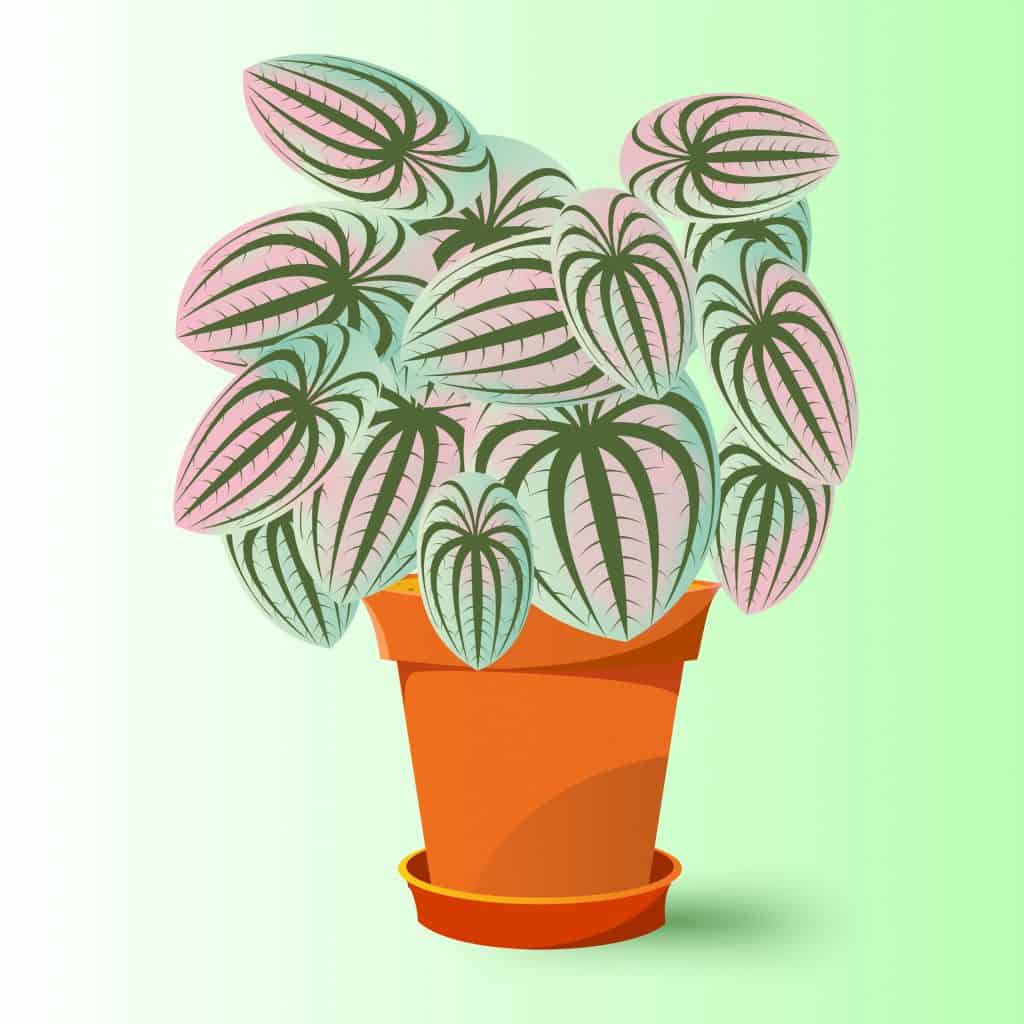Pink Lady Peperomia is a tropical mounding plant that is native to Central and South America and is also found in the Caribbean. Fleshy stems, heart-shaped, characterize the Pink Lady Peperomia, deeply rippled leaves and a beautiful color blend of green, pink, and cream. This unique coloring makes this peperomia variety popular amongst gardening enthusiasts and gives this plant its common name. The coloring and variegation are affected by the amount of light provided and will vary from plant to plant.
There are over 1,000 different types of peperomias, but the Pink Lady Peperomia is a rare variety of this common epiphyte. These evergreen perennial plants make great houseplants and are also suitable in terrariums. Pink Ladies are a non-toxic plant, making them safe to keep inside homes with animals and small children like other peperomias.
Pink Lady Peperomia Care
The Pink Lady Peperomia is a very easy plant to care for, as it is tolerant of environmental changes. This makes it an excellent choice for beginners in gardening. However, with the combination of low maintenance and stunning colors, the Pink Lady Peperomia makes an ideal houseplant for anyone in the hobby, regardless of experience or skill level.
Lighting Requirement
A Pink Lady Peperomia will thrive in medium to bright indirect sunlight. Bright light helps maintain the vibrant coloration of this plant, but keeping the light filtered or partial is ideal since direct sunlight may burn the leaves. On the other hand, insufficient light may result in dull coloring, dropped leaves, or a drooping plant. Alternatively, you may use 12 to 16 hours of artificial light for the Pink Lady, especially in the winter when this plant may need to be kept indoors.

Soil Requirement
The Pink Lady Peperomia should be kept in a chunky, well-draining, and acidic soil blend. Orchid potting mix is a good choice for this plant. You can also use a standard potting mix, although adding 10% to 20% perlite is recommended for added drainage. Other additions that would be beneficial in this plant’s soil blend are peat moss, vermiculture, and fir bark. Making sure that the soil allows for proper drainage is essential since the Pink Lady hates to sit in soggy soil, and doing so will leave this plant susceptible to pests and fungal infections.
pH Requirement
Pink Lady Peperomias typically grow as epiphytes, rooting themselves in the branches or base of trees and deriving some of their nutrients from the decaying matter within the tree. This decaying matter is acidic, so that peperomia will prefer acidic environments. Keeping their soil at a pH level of 6.1 to 6.5 is ideal.
Watering
A Pink Lady Peperomia should not be overwatered. You can check the soil weekly, but it is recommended to let the top few inches of soil dry out between waterings. The Pink Lady Peperomia, while generally easy to care for, is very sensitive to being overwatered and will likely get root rot if you do so. It is better to err on the side of caution and underwater rather than potentially overwatering this plant, so when you doubt whether you should water your Pink Lady, choose not to. This plant will also require less watering in the winter but can be misted if the air becomes too dry.
Temperature
The Pink Lady Peperomia is found in tropical regions and thrives in warmer temperatures. A Pink Lady Peperomia plant is also very humidity tolerant. The Pink Lady will do best in temperatures ranging from 61°F to 81°F (16°C to 27°C) and in 40% to 50% humidity. This plant should not be kept in temperatures lower than 30°F (-1°C), so if you live in an area that reaches these temperatures in the wintertime, it is recommended to bring the peperomia inside during these months. It is also advised to reduce watering in the winter since the plant’s growth rate will slow down this season, and it is more likely to experience overwatering.
Fertilization
Pink Lady Peperomias typically receive their nutrients from the air, water, and light provided in their environment. Therefore, fertilization is rarely necessary and may not be required at all. If you choose to add fertilization to this plant, use a balanced feed every couple of weeks during its growing season in the spring and summer seasons.
Propagation Method
The Pink Lady Peperomia is relatively easy to propagate. This plant can be propagated from leaves, stems, or tips in water and soil.
If propagating a Pink Lady Peperomia in water, cut a healthy stalk from your plant and place it in a shallow water container. The stalk should begin to grow new roots in 1 to 2 months, and once it has, you can transfer the stalk into a small pot. Use well-draining soil and keep its environment humid, misting the plant if needed.
Pink Lady Peperomias can be propagated in soil from any part of the plant. Use stems, leaves, or tips from a healthy plant; ideally, use stems with a node and a few leaves on them. Dip the base of the cutting into a rooting powder and plant it into a small pot filled with well-draining soil. Use a plastic bag with holes for proper air circulation to cover the new plant. It may be beneficial to uncover the plant every couple of days to give it more air and prevent mold from growing. Keep the pot in bright indirect sunlight, and you should see new growth within several weeks.
Once your peperomia is rooted, and new plants are sprouted, provide your new Pink Lady with the same care as your others.
Size & Growth Rate
Pink Lady Peperomias are a slow-growing plant, with most of their growth happening during spring and summer. When purchased, these plants typically start off only a couple of inches small, but over time they can grow up to 12 inches in height and width.
Flowering
While Pink Lady Peperomias are capable of flowering, they rarely do. Their flowers are white spikes stemming from the leaves, and any flowering will typically be seen during spring or summer. If you see flowering from your Pink Lady Peperomia, it is very well cared for.
Repotting
Pink Lady Peperomias have shallow root systems so that they can be kept in small and shallow pots. These plants prefer to be root bound and, therefore, should not be repotted often; it can take years for them to need it. The Pink Lady can be repotted when you see the roots coming out of their drainage holes, and when repotting, it is ideal to place them in a pot that is only a couple of inches larger than their current pot.
Common Issues, Pests, and Diseases
The Pink Lady Peperomia may experience issues with common pests such as spider mites, aphids, mealy bugs, fungus gnats, and whiteflies. The main cause for any of these infestations is typically overwatering or lack of air circulation. Pruning the plant and removing dead leaves will also help to prevent infestations. If you find any of these bugs on your Pink Lady, using a store-bought or homemade insecticidal soap is the best treatment for the plant.
Another issue you may encounter with your Pink Lady Peperomia is root rot. Root rot, typically caused by overwatering, is a disease that attacks the roots of a plant, causing them to rot and decay and hindering them from absorbing nutrients. If root rot is left untreated, it can be lethal for your plant. Root rot symptoms include wilted, brown, or dropped leaves and slowed growth, while the roots will become brown and mushy.
If you notice your peperomia is affected by this disease, you can take steps to save it. Remove the plant from its soil, wash the roots, and use scissors to cut the diseased roots away. Spray your plant’s roots with a fungicide solution or a mixture of hydrogen peroxide and water. Use a new, disinfected pot filled with new well-draining soil to repot the plant.
Where to Find Pink Lady Peperomias for Sale?
While peperomias are commonly found in well-known plant and gardening stores, the Pink Lady Peperomia is a rare variety and can be harder to find. You may find luck in smaller local plant stores or specialty stores. However, a popular website that tends always to have Pink Ladies in stock is Etsy. A Pink Lady Peperomia will range in price from $15 to $50, depending on your size and where you purchase it.
Pink Lady Peperomia vs. Pink Marble Peperomia
The main difference between these peperomia varieties is their coloring. They are commonly mistaken for each other due to having the same heart-shaped and furrowed leaves and for having pink coloration. However, the Pink Lady Peperomia has a green leaf with splashes of cream and pale pink, while the Pink Marble Peperomia is a deep emerald green with a silver sheen and hot pink marbling throughout. The general care for these plants is the same. They both prefer bright indirect light, dry soil, and tropical temperatures. Overall, both varieties of peperomias are low-maintenance plants to have.
